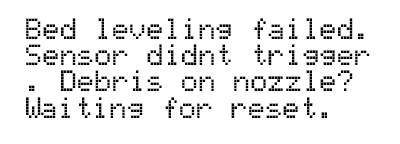The Bed leveling failed error appears when there is something wrong with the last stage of the calibration. This calibration is the last step of XYZ calibration and is performed before each print.
For MK2.5/MK2.5S printers that have the SuperPINDA installed, you MUST use firmware version 3.9.3, or above!
There can be three different error messages related to the Bed leveling failed:
- Sensor didnt trigger. Debris on nozzle? Waiting for reset.
- Sensor triggered too high. Waiting for reset.
- Sensor disconnected or cable broken. Waiting for reset.

Troubleshooting
"Sensor didn't trigger. Debris on nozzle? Waiting for reset"
- Make sure the nozzle and heatbed are clear of any plastic.
- Do the Z calibration through the LCD Menu - Calibration - Calibrate Z, which also levels the X-axis.
- Try to resume the calibration or start the print again (depending on when the error occurred).
- If you are still struggling with these error messages, it is recommended to go through the whole calibration again. You can follow this walkthrough XYZ-calibration error-messages (MK3/MK3S/MK3S+) or XYZ Calibration error-messages (MK2/S).
"Sensor triggered too high. Waiting for reset."
- Make sure the hotend is fully inserted into the extruder.
- Do the Z calibration through the LCD Menu - Calibration - Calibrate Z, which also levels the X-axis.
- Try to resume the calibration or start the print again (depending on when the error occurred).
- If you are still struggling with these error messages, it is recommended to go through the whole calibration again. You can follow this walkthrough XYZ-calibration error-messages (MK3/MK3S/MK3S+) or XYZ Calibration error-messages (MK2/S).
Sensor disconnected or cable broken. Waiting for reset.
- Make sure that the P.I.N.D.A. sensor is properly plugged into the electronics board. You can double-check that using the Einsy RAMBo electronics wiring (MK3/MK3S/MK3S+) or Mini RAMBo electronics wiring (MK2S, MK2.5, MK2.5S) guides.
- Visually check the PINDA sensor cable, look for any overtightened zip-ties which might be preventing the P.I.N.D.A. sensor to work properly.
- Check the PINDA sensor, you can find more information on how to do that at P.I.N.D.A./SuperPINDA Sensor testing.
After adjusting the PINDA sensor or any other hardware, we recommend running the Calibration Wizard from the beginning.